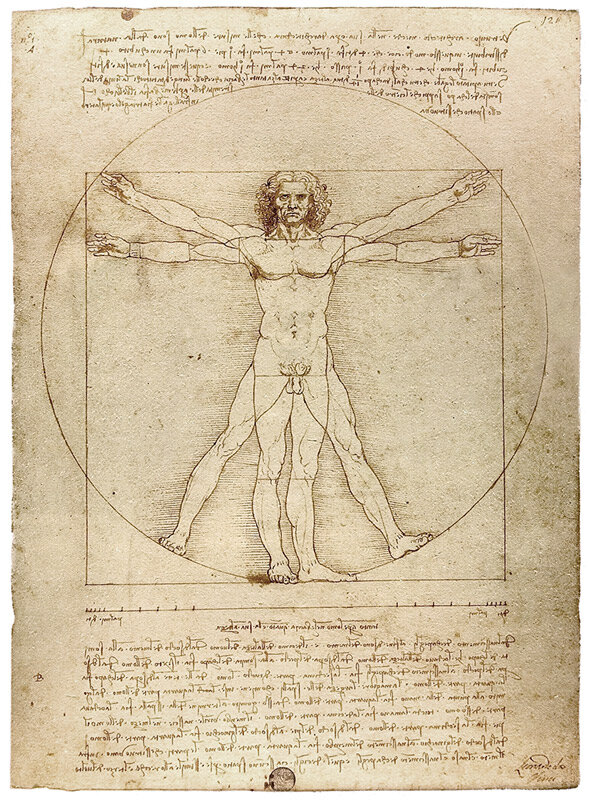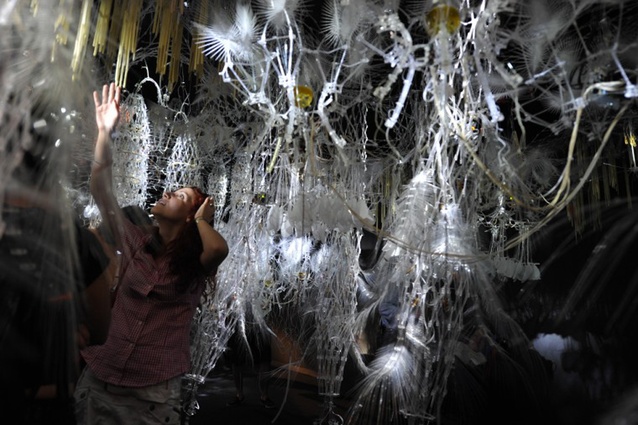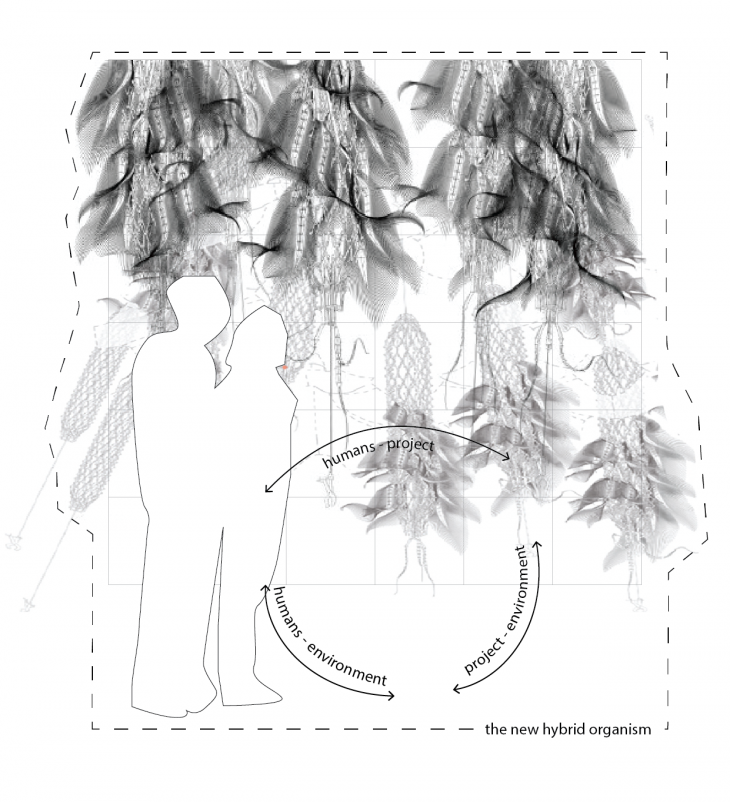Tracing the Technonatural
The research analyses the application of technonature in Post-humanist theory while referencing the hybridity of the Eyeborg project by Neil Harbisson and in light of the current technological, and socio-political climate landscape. It looks at Philip Beesley’s Hylozoic Ground installation which blurred the divide between the artificial and the natural and concludes that to effectively blur such boundaries between technology and nature it will require a more rigorous distancing of a binary, human centered way of thinking.
Humans have perceived and related to nature from the Judeo-Christian myth of the Fall of Man and the western humanist tradition where Man is seen as intrinsically moral, tasked to protect a sacred nature that is threatened by human technology and exploitation. However, this sentiment is no longer relevant to the current cultural landscape of technologically driven relationships. It does not address the complexity and dissolution of the central figure that exists today. With a technonatural perspective the conversation expands beyond the dichotomy between ‘man(made)’ versus ‘natural’ and addresses the fluid relationships between ecologies, bodies, and technologies.

The Fall of Man, Titian, 1550.

‘Innocence’, William Adolphe Bouguereau, 1893

‘Vitruvian Man’, Da Vinci, c.1490.
Framing a new approach to Environmentalism
Activists like Greta Thurnberg are taking a stance against this conservative, humanist approach while reframing the conversation to unify behind science, demystify the climate crisis and encourage immediate action. For Greta, “it will take ‘cathedral thinking’.” and while the idea of local versus global impact has already entered the conversation, Greta makes more apparent the lasting effect that this humanist view on climate change will have well into the future.
In place of anthropocentrism, Technonature seeks to displace humanity from the center of reference and of power. It proposes an outlook which recognizes a complex and dynamic network of centers that co-exist and operate simultaneously, thus eliminating the binary of a singular center versus margins. Greta’s activism seeks to do much the same through a bottom up approach that is seen throughout many other cultural movements today, where intersectional perspectives place the issue of equality as a bi-product of the humanist center. In a technonatural framework, we approach the subject from various perspectives, define it not as in opposition to an outcast Other, and understand how beings can embody multiple identities at varying forms of hybridity.

Greta Thunberg, New York Times, 2018.
“The posthuman predicament is such as to force a displacement of the lines of demarcation between structural differences, or ontological categories, for instance between the organic and the inorganic, the born and the manufactured, flesh and metal, electronic circuits and organic nervous systems.”
– Braidotti, The Posthuman
Braidotti’s “Posthuman” and Cyborgs
In Posthuman, Braidotti radically blurs the separation between humans, non-humans, and technology. Her critical posthumanism acknowledges a technology integrated nature with a Spinozist all-is-one perspective that is consistent with modern scientific understanding of self-organising and interconnected living structures.
The cyborg, as Donna Harraway highlights, is also part of this technonatural world. It breaches three important boundaries: the human/animal, the organism/machine, and the physical/non-physical. The case of Neil Harbisson’s Eyeborg exemplifies the shattering of these boundaries. Fueled by the desire to overcome his colour blindness, in 2003 Harbisson implanted a device in his head which senses the colour spectrum of an object, translates it into sound frequencies that are transmitted to his brain and allow him to hear color. Interestingly, the Eyeborg calls attention to the one boundary Harbisson did not break – between the physical and the non-physical – as his “eye” is visible and it is impossible to forget his dependence on it.

Neil Harbisson and the Eyeborg, Freethink
Advancements in Technology
Currently, modern advances in technology are already bringing cyborgs closer to Harraway’s description, and thereby to technonature. This is evident in the current use of Arduinos in Hylozoic Ground, which mimics life in three manners, in form, in the production of material, and perhaps most importantly in the decision-making processes that determine the project’s interactive responses. Arduinos form an autonomic nervous system and establish a regulated network to maintain its physical body in homeostasis according to external triggers. At local levels, the reactions are open-ended but predictable.
These low-level reactions are modulated by local command centers, which self-regulate according to neighbouring clusters, and accumulate to more complex responses at a global level. This mediated, self-renewing response fulfils an important criterion of the expansive system – autopoeisis. Moreover, the project adopts biochemical processes, forming new matter to sustain its relationship with the external environment. By combining living processes, self regulatory protocols, as well as interaction to the occupants within its space, Hylozoic Ground merges technological and biological processes, thus forming a new technonatural hybridity in which these two are inseparable.
The Hylozoic Ground
In 2010, architect Philip Beesley installed Hylozoic Ground for the Canadian pavilion at the Architecture Biennale of Venice. Designed to interact with a variety of stimuli, from humans to air humidity, Hylozoic Ground is an ambitious experimental project that reimagines architecture by deliberately erasing the line between the artificial, man-made world of architecture and the traditional sacred notion of nature.

Hylozoic Ground, Philip Beesley

Hylozoic Ground epitomizes Braidotti’s concept of a ‘becoming machine’ – which asks the subject to actively embody this human-nature-technological boundary-blurring identity. Hylozoic Ground does so by facilitating interrelations between itself and its occupants (us) which become part of a shared environment via biochemical and electronic processes. Indeed, the project addresses the relational powers external to the dualistic frame. It is then understood not as representing life, but as a new life in itself, upholding new symbiotic relationships between the occupant and the technologically-mediated environment and forming a larger indivisible techno biological hybrid organism.
Conclusion
Hylozoic Ground is still inconsistent to the technonatural mindset and posthuman design. Firstly, its creators have not been able to escape the pitfalls of the binary Humanist stance. This can be seen in Beesley’s original design intention: to create a new environment antithetical to ‘nature’. Yet, the final result resembles a living forestial canopy, or a mycelial structure with an electronic neural network. Paradoxically, the project still relies heavily on the imagery of the forest and implies that technology is recognized as nature only when it follows a naturalistic form, contrary to the technonaturalistic view that would already consider it nature. At the same time, such fear-based projections of meanings from the visitors denote a particular success of decentering humans, for we tend to be wary of that which doesn’t reflect us.
Secondly, is the project truly a flagship of a posthuman autopoietic system? Taking for comparison Dolly the sheep, who existed through human intervention, but was rather autonomous in reproducing, assimilating energy, and interacting with her human and non human co-occupants/environment. Whereas Hylozoic Ground, as it currently stands, has its presence commodified for human consumption; its sustained existence is dependent on the energy and (exhibit) space given by humans. It still centers humans, and relies on their permission to exist, replicate, or be dismantled. In this light, Hylozoic Ground is merely a first product of an emerging technonatural design practice in architecture.
If we formulate technonaturalism as a complex network of symbioses between humans and non-humans, these questions may not even hold ground, for we are meant to be interdependent. One can still ask, however, about what a true autonomous technonatural hybrid organism would be.
Tracing the Technonatural: Hylozoic Ground is a project of IaaC, Institute for Advanced Architecture of Catalonia developed at the Master in Advanced Architecture in 2020/2021 by Students: Abrar Ali, Michelle Bezik, Cecile Ngoc Suong Perdu, Christos Trompoukis and Faculty: Manuel Gausa, Jordi Vivaldi Piera
